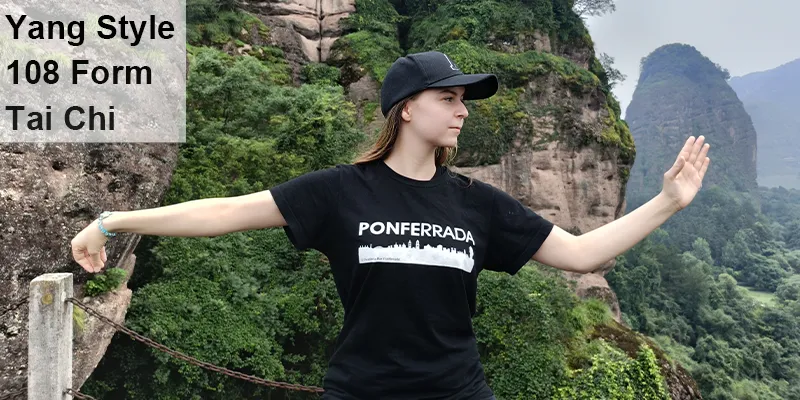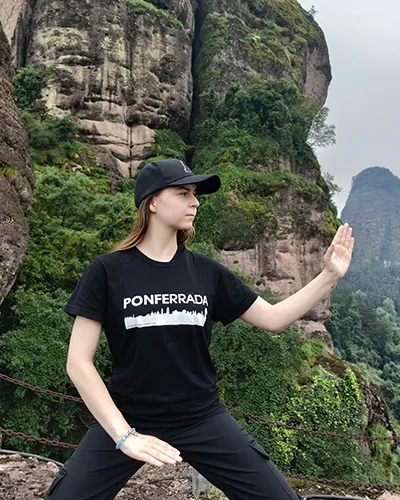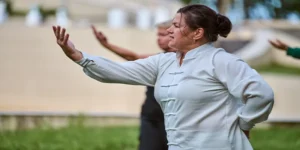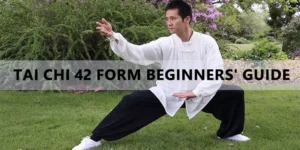108 form tai chi is one of the most comprehensive kungfus in traditional Yang Style Tai Chi. Whether you’re a beginner or an advanced practitioner, mastering the 108 moves of Tai Chi can enhance balance, flexibility, and mental clarity.

In this guide, you’ll know the history, benefits, and structure of the Tai Chi 108 Form, along with resources like instructional videos on Tai Chi 108 moves YouTube.
What Is The 108 Form Tai Chi?
Yang style 108 Tai Chi is one of the most classic and complete traditional routines in Tai Chi. It is famous for its stretching, gentle, slow, and flexible characteristics. As a representative long routine of Yang Style Tai Chi, 108 form tai chi integrates health, martial arts, and wisdom and is suitable for long-term practitioners to study in depth. The name “Yang Style 108 Forms Tai Chi” contains 3 key information:

- “Yang Style”—Tai Chi style (created by Yang Luchan).
- “108 Forms” – the number of movements.
- “Tai Chi” – belongs to the Chinese martial arts system.
Key Features of the 108 Tai Chi Moves List
Full Structure
- 108 Tai Chi Movements: It covers all fundamental Tai Chi techniques.
- Balanced Sections: Divided into 6 parts, making it easier to learn.
- Full-Body Engagement: Works on upper body, lower body, and core in harmony.
Flowing Movements
- Soft and Continuous: No abrupt stops; each move flows into the next like a river.
- Spiral Force: Many moves use twisting motions to develop internal energy.
- Large and Open Moves: Wide movements, promoting flexibility and relaxation.
Martial and Self-Defense
- Every move has combat meaning. Hidden power in slow motion: though the moves are gentle, each technique bursts with explosive force.
Health and Meditation Benefits
- Deep Breathing: Natural abdominal breathing benefits oxygen flow.
- Meridian Stimulation: Gentle stretches improve Qi circulation in energy pathways.
- Stress Relief: The slow rhythm induces a meditative state, calming your mind.
Traditional Chinese Cultural Significance
- Based on Daoist philosophy, it follows principles of wu wei and natural harmony.
- 108 Symbolism: It symbolizes perfection (like 108 beads in Buddhist mala).
- Historical Lineage: Passed down from Yang Luchan → Yang Chengfu to modern masters.
108 Form Tai Chi Steps
There are three parts to 108 form Tai Chi. The first part contains 1-16 steps, the second part contains 17-56 steps, and the third part contains 57-108 steps. The 108 tai chi moves list as follows
Part 1
| Step Number | Step Name | Chinese Name | English Name |
| 1 | 起式 | Qi Shi | Beginning |
| 2 | 左掤 | Zuo Peng | Ward-off (Left) |
| 3 | 拦雀尾 | Lan Que Wei | Grasp the sparrow’s tail |
| 4 | 单鞭 | Dan Bian | Single whip |
| 5 | 提手上势 | Ti Shou Shang Shi | Step up to raise hands (also Raise Hands and Step Forward) |
| 6 | 白鹤凉翅 | Bai He Liang Chi | White Crane spreads its wings |
| 7 | 左搂膝拗步 | Zuo Lou Xi Ao Bu | Brush left knee and push |
| 8 | 手挥琵琶 | Shou Hui Pi Pa | Hand strums the lute (play the pipa) |
| 9 | 左搂膝拗步 | Zuo Lou Xi Ao Bu | Brush left knee and push |
| 10 | 右搂膝拗步 | You Lou Xi Ao Bu | Brush right knee push |
| 11 | 左搂膝拗步 | Zuo Lou Xi Ao Bu | Brush left knee push |
| 12 | 手挥琵琶 | Shou Hui Pi Pa | Hand strums the lute (pipa) |
| 13 | 左搂膝拗步 | Zuo Lou Xi Ao Bu | Brush left knee push (left) |
| 14 | 进步搬拦捶 | Jin Bu Ban Lan Chui | Twist, deflect, step, parry and punch (also Step Forward, Parry Block and Punch) |
| 15 | 如封似闭 | Ru Feng Si Bi | Apparent close up |
| 16 | 十字手 | Shi Zi Shou | Cross hands |
Part 2
| Step Number | Step Name | Chinese Name | English Name |
| 17 | 抱虎归山 | Bao Hu Gui Shan | Embrace the Tiger and Return to Mountain (also Carry the tiger to the mountain) |
| 18 | 拦雀尾 | Lan Que Wei | Grasp the sparrow’s tail |
| 19 | 肘底捶 | Zhou Di Chui | Fist under elbow |
| 20 | 右倒撵猴 | You Dao Nian Hou | Retreat to repulse monkey (right) |
| 21 | 左倒撵猴 | Zuo Dao Nian Hou | Retreat to repulse monkey (left) |
| 22 | 右倒撵猴 | You Dao Nian Hou | Retreat to repulse monkey (right) |
| 23 | 左倒撵猴 | Zuo Dao Nian Hou | Retreat to repulse monkey (left) |
| 24 | 右倒撵猴 | You Dao Nian Hou | Retreat to repulse monkey(right) |
| 25 | 斜飞式 | Xie Fei Shi | Oblique/Diagonal flying |
| 26 | 提手上势 | Ti Shou Shang Shi | Step up to raise hands |
| 27 | 白鹤凉翅 | Bai He Liang Chi | White Crane spreads its wings |
| 28 | 左搂膝拗步 | Zuo Lou Xi Ao Bu | Brush left knee and push |
| 29 | 海底针 | Hai Di Zhen | Needle to the bottom of the sea |
| 30 | 扇通背 | Shan Tong Bei | Fan through the back |
| 31 | 转身撇身捶 | Zhuan Shen Pie Shen Chui | Turn Body and Chop with Fist |
| 32 | 进步搬拦捶 | Jin Bu Ban Lan Chui | Twist, deflect, step, parry, punch |
| 33 | 拦雀尾 | Lan Que Wei | Grasp the sparrow’s tail |
| 34 | 单鞭 | Dan Bian | Single whip |
| 35 | 云手 | Zuo You Yun Shou | Cloud hands (several times) |
| 36 | 单鞭 | Dan Bian | Single whip |
| 37 | 高探马 | Gao Tan Ma | High pat on horse |
| 38 | 右分脚 | You Fen Jiao | Parting/separation kick (right) |
| 39 | 左分脚 | Zuo Fen Jiao | Parting/separation kick (left) |
| 40 | 转身左蹬脚 | Zhuan Shen Zuo Deng Jiao | Turn and kick with left heel |
| 41 | 左搂膝拗步 | Zuo Lou Xi Ao Bu | Brush left knee and push |
| 42 | 右搂膝拗步 | You Lou Xi Ao Bu | Brush right knee push |
| 43 | 左搂膝拗步 | Zuo Lou Xi Ao Bu | Brush left knee and push |
| 44 | 进步栽捶 | Jin Bu Zai Chui | Step up, Punch Down |
| 45 | 转身撇身锤 | Zhuan Shen Pie Shen | Turn Body and Chop with Fist |
| 46 | 进步搬拦锤 | Jin Bu Ban Lan Chui | Twist, deflect, step, parry and punch |
| 47 | 右蹬脚 | You Deng Jiao | Right heel kick |
| 48 | 左打虎式 | Zuo Da Hu Shi | Hit/strike tiger (left) |
| 49 | 右打虎式 | You Da Hu Shi | Hit/strike tiger (right) |
| 50 | 回身右蹬脚 | Hui Shen You Deng Jiao | Turn Body and Right Heel Kick |
| 51 | 双峰灌耳 | Shuang Feng Guan Er | Twin Fists Strike Opponents Ears |
| 52 | 左蹬脚 | Zuo Deng Jiao | Left heel kick |
| 53 | 转身右蹬脚 | Zhuan Shen You Deng Jiao | Spin and kick with right heel |
| 54 | 进步搬拦捶 | Jin Bu Ban Lan Chui | Twist, deflect, step, parry, punch |
| 55 | 如封似闭 | Ru Feng Si Bi | Apparent close up |
| 56 | 十字手 | Shi Zi Shou | Cross hands |
Part 3
| 57 | 抱虎归山 | Bao Hu Gui Shan | Embrace the Tiger and Return to Mountain (also Carry the tiger to the mountain) |
| 58 | 斜单鞭 | Xie Dan Bian | Oblique/diagonal single whip |
| 59 | 右野马分鬃 | You Ye Ma Fen Zong | Parting Wild Horse’s Mane, Right |
| 60 | 左野马分鬃 | Zuo Ye Ma Fen Zong | Parting Wild Horse’s Mane, Left |
| 61 | 右野马分鬃 | You Ye Ma Fen Zong | Parting Wild Horse’s Mane, Right |
| 62 | 左野马分鬃 | Zuo Ye Ma Fen Zong | Parting Wild Horse’s Mane, Left |
| 63 | 右野马分鬃 | You Ye Ma Fen Zong | Parting Wild Horse’s Mane, Right |
| 64 | 左掤 | Zuo Peng | Ward-off (Left) |
| 65 | 拦雀尾 | Lan Que Wei | Grasp the sparrow’s tail |
| 66 | 单鞭 | Dan Bian | Single whip |
| 67 | 玉女穿梭 | Yu Nu Chuan Suo | Fair Lady works at shuttles (also Jade maiden weaves shuttles (left)) |
| 68 | 玉女穿梭 | Yu Nu Chuan Suo | Fair Lady works at shuttles (also Jade maiden weaves shuttles (right)) |
| 69 | 玉女穿梭 | Yu Nu Chuan Suo | Fair Lady works at shuttles (also Jade maiden weaves shuttles (left)) |
| 70 | 玉女穿梭 | Yu Nu Chuan Suo | Fair Lady works at shuttles (also Jade maiden weaves shuttles (right)) |
| 71 | 左掤 | Zuo Peng | Ward-off (Left) |
| 72 | 拦雀尾 | Lan Que Wei | Grasp the sparrow’s tail (right) |
| 73 | 单鞭 | Dan Bian | Single whip |
| 74 | 云手 | Zuo You Yun Shou | Cloud hands (several times) |
| 75 | 单鞭 | Dan Bian | Single whip |
| 76 | 下势 | Xia Shi | Snake creeps down |
| 77 | 左金鸡独立 | Zuo Jin Ji Du Li | Golden Rooster stands on left leg |
| 78 | 右金鸡独立 | You Jin Ji Du Li | Golden Rooster stands on right leg |
| 79 | 右倒撵猴 | Zuo Dao Nian Hou | Retreat to repulse monkey (right) |
| 80 | 左倒撵猴 | You Dao Nian Hou | Retreat to repulse monkey (left) |
| 81 | 右倒撵猴 | Zuo Dao Nian Hou | Retreat to repulse monkey (right) |
| 82 | 左倒撵猴 | You Dao Nian Hou | Retreat to repulse monkey (left) |
| 83 | 右倒撵猴 | Zuo Dao Nian Hou | Retreat to repulse monkey(right) |
| 84 | 斜飞式 | Xie Fei Shi | Oblique/Diagonal flying |
| 85 | 提手上势 | Ti Shou Shang Shi | Step up to raise hands |
| 86 | 白鹤凉翅 | Bai He Liang Chi | White Crane spreads its wings |
| 87 | 左搂膝拗步 | Zuo Lou Xi Ao Bu | Brush left knee and push |
| 88 | 海底针 | Hai Di Zhen | Needle to the bottom of the sea |
| 89 | 扇通背 | Shan Tong Bei | Fan through the back |
| 90 | 转身白蛇吐 | Zhuan Shen Bai She Tu Xin | Turn Body and White Snake Spits out Tongue |
| 91 | 进步搬拦捶 | Jin Bu Ban Lan Chui | Twist, deflect, step, parry, punch |
| 92 | 拦雀尾 | Lan Que Wei | Grasp the sparrow’s tail |
| 93 | 单鞭 | Dan Bian | Single whip |
| 94 | 云手 | Zuo You Yun Shou | Cloud hands (several times) |
| 95 | 高探马 | Gao Tan Ma | High pat on horse |
| 96 | 穿掌 | Chuan Zhang | Cross Palm or Palm Thrust |
| 97 | 十字腿 | Shi Zi Tui | Cross leg kick |
| 98 | 进步指裆锤 | Jin Bu Zhi Dang Chui | Step forward and punch groin |
| 99 | 上步拦雀尾 | Shang Bu Lan Que Wei | Walking/Step Forward and Grasp the sparrow’s tail |
| 100 | 单鞭 | Dan Bian | Single whip |
| 101 | 下势 | Xia Shi | Snake creeps down |
| 102 | 上步七星 | Shang Bu Qi Xing | Step up to form the seven stars |
| 103 | 退步跨虎 | Tui Bu Kua Hu | Sit/Step back to ride the tiger |
| 104 | 转身摆莲 | Zhuan Shen Bai Lian | Turn body and swing over lotus |
| 105 | 弯弓射虎 | Wan Gong She Hu | Draw the bow to shoot the tiger |
| 106 | 进步搬拦捶 | Jin Bu Ban Lan Chui | Twist, deflect, step, parry, punch |
| 107 | 如封似闭 | Ru Feng Si Bi | Apparent close & counter with push |
| 108 | 十字手 | Shi Zi Shou | Cross hands |
Awareness Tai Chi 108 Moves
The “Awareness Tai Chi 108 Moves” is a full and meditative form of Tai Chi that focus on mindfulness, fluid movement, and Qi. The awarness 108 move is a traditional long-form practice, derived from Yang style Tai Chi, but with a strong focus on awareness, relaxation, and internal energy flow.
Unlike physical Tai Chi forms, this practice integrates deep mental focus, breath synchronization, and body awareness. Each movement is performed with intention, fostering a meditative state.
FAQs
Is tai chi a religion?
Tai Chi, also known as Tai Chi Chuan, is not a religion. It is a Chinese martial art and mind-body practice that combines slow movements, meditation, and breathing exercises. However, its origins are deeply rooted in Chinese philosophy, particularly Taoism (Daoism), which focus on harmony with nature, balance, and the flow of energy.
Tai Chi is more of philosophical or spiritual worldview than a structured religion. Most practitioners in Tai Chi for its health benefits rather than spiritual or religious reasons. It is often as a form of exercise or moving meditation. Tai Chi has no dogma, sacred texts, or religious hierarchy.
What to wear for tai chi?
When practicing Tai Chi, comfort, flexibility, and free moves are key. The tai chi clothing allows you to move flexible while maintaining posture and breathing.
Choosing lightweight, loose clothing like cotton, linen, or synthetic blends. Avoid stiff or tight fabrics that restrict your movement. Loose-fitting tunic, T-shirt, or tank top paired with wide-leg pants, yoga pants, or traditional Tai Chi/Kung Fu trousers.
Good grip like Tai Chi shoes, ballet flats, or minimalist sneakers are ideal. The soles make you to feel the ground and pivot easily. Many practitioners go barefoot or wear grip socks on smooth indoor surfaces to enhance balance and grounding.
Where can I learn tai chi near me?
To find Tai Chi classes near you, try these methods:
Online Search
- Google: “Tai Chi classes near [your city/zip]”
- Check platforms like Meetup, Eventbrite, or Yelp for local groups.
Parks And Outdoor Groups
- Many cities have free or donation-based Tai Chi sessions in public parks especially in Chinatowns or Asian cultural centers.
Senior Centers
- Some hospitals and wellness centers offer Tai Chi for stress relief and balance improvement.
Online Tai Chi
- YouTube likeTai Chi for Beginners by Dr. Paul Lam
Would you like help your search based on your location? Let me know your city or region, and I can suggest specific places!
How to become a tai chi instructor?
Becoming a Tai Chi instructor requires to practice, deep understanding of the art, and formal training.
- Strong Personal Practice
- Begin practicing Tai Chi regularly for 3–5+ years to build forms, postures, and principles. Explore your major styles like Yang, Chen, Wu, or Sun to broaden your knowledge. Learn the Taoist principles, yin-yang theory, and qi concepts that over Tai Chi.
- Choose Qualified Teacher
- Find a reputable instructor with lineage in a recognized Tai Chi style. Attend workshops or retreats to refine your skills and deepen your understanding.
- Deepen Your Knowledge
- Study qigong and integrate it into your teaching. Learn anatomy, biomechanics, and how Tai Chi benefits health.
- Get Certified
- Complete your teacher training program through a recognized Tai Chi school or organization (e.g., Tai Chi Union, ITCCA, or local associations). Certification often include:
- Demonstrating advanced forms.
- Understanding teaching methodologies.
- Passing written/oral exams on theory.
- Obtain CPR/first aid certification.
- Complete your teacher training program through a recognized Tai Chi school or organization (e.g., Tai Chi Union, ITCCA, or local associations). Certification often include:
- Gain Teaching Experience
- Start by assisting your teacher in classes.
- Teach small groups (friends, community centers) to build confidence.
- Volunteer at senior centers or wellness programs to work with diverse populations.
- Develop Your Teaching Style
- Adapt lessons for different audiences (seniors, athletes, stress management). And learn to give clear corrections and modifications for injuries/limitations.



